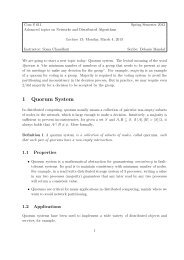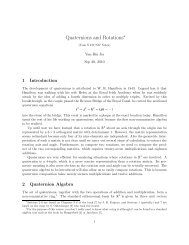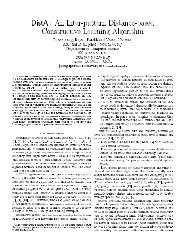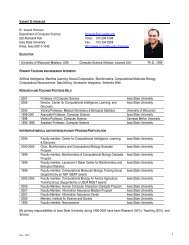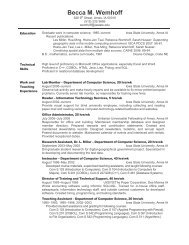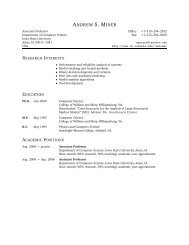Algebraic Curves∗
Algebraic Curves∗
Algebraic Curves∗
Create successful ePaper yourself
Turn your PDF publications into a flip-book with our unique Google optimized e-Paper software.
Some plane curves appear to have several parts. The simplest example of this is the hyperbola,<br />
which has two unbounded parts that do not meet in the plane. We now give an example of a<br />
cubic curve 2 which appears to have two parts, one of which is bounded and the other of which is<br />
unbounded.<br />
The algebraic equation is<br />
A parametric equation of the curve is<br />
y 2 − x 3 + x = 0.<br />
x = t, y = ± √ t(t 2 − 1) −1 ≤ t ≤ 0 or t ≥ 1.<br />
This parameterization by x is given by solving the algebraic equation to give y as a function of x.<br />
We determine where the line x = t meets the curve for each fixed value of t. Substituting x = t<br />
into y 2 − x 3 + x = 0 gives y 2 − t 3 + t = 0. Solving this gives x = t, y = ± √ t(t 2 − 1). This gives<br />
parameterizations of four parts of the curves, one in each of the four quadrants. These parametric<br />
equations are not differentiable at t = 0, ±1.<br />
An algebraic curve can be parametrized in many different ways. An alternative parametric<br />
equation is given by determining where the line y = tx meets the curve for each fixed value of t.<br />
Substituting y = tx into y 2 − x 3 + x = 0 gives x(t 2 x − x 2 + 1) = 0. Solving this gives the origin<br />
(x,y) = 0, the parameterization<br />
r(t) = 1 (<br />
t 2 − √ (<br />
t<br />
2<br />
4 + 4,t t 2 − √ ))<br />
t 4 + 4<br />
of the bounded part of the curve and the parameterization<br />
r(t) = 1 (<br />
t 2 + √ (<br />
t<br />
2<br />
4 + 4,t t 2 + √ ))<br />
t 4 + 4<br />
of the unbounded part. The origin is not covered by the parameterization of the bounded part,<br />
because it corresponds to the value ∞ of the parameter, that is, to the vertical line x = 0. These<br />
two parameterization are differentiable for all values of t.<br />
2 The figure is taken from [1, p. 60].<br />
3



